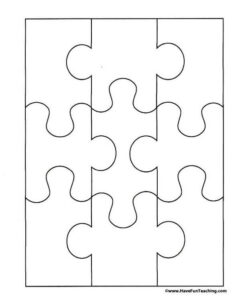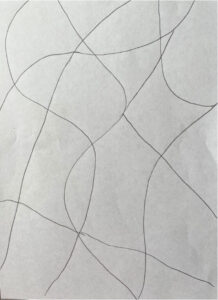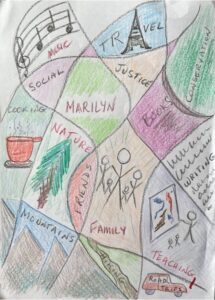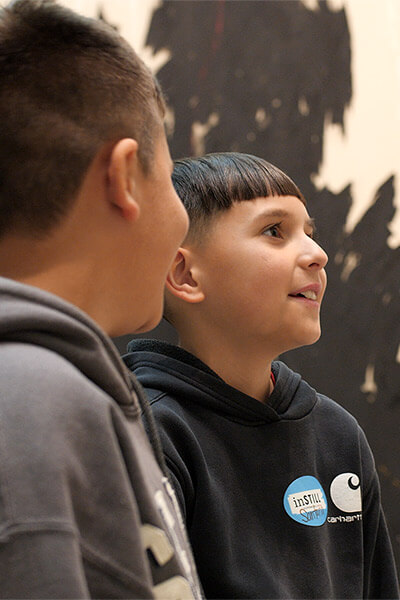By Marilyn Lindenbaum, Clyfford Still Museum Educator
Summary/Purpose:
The purpose of this activity is to explore self-identity through art in order to think more deeply about ourselves, our communities and our world. Students will look at a Clyfford Still abstract painting and make inferences about Still and his art. Their ideas will be captured on a puzzle template as a model for their own identity puzzle to follow. The puzzle format will help students to organize their self- exploration while providing an engaging format.
Big Idea:
- I belong in creative spaces that allow me to be myself and connect with others.
Essential Questions:
- What are creative spaces?
- What does belonging feel like?
- How do I exist within my communities?
Learning Targets:
- I can be myself
- I can connect with my communities
- I can welcome creativity into my world
Time:
- 30 – 40 minutes depending on grade level and attention span
Materials:
- Paper
- Drawing Supplies
- PH-1082 by Clyfford Still
- Jigsaw puzzle template (optional)
Standards:
Colorado Visual Arts Standards:
- Standard 1: Observe and Learn to Comprehend
- Standard 3: Invent and Discover to Create
- Standard 4: Relate and Connect to Transfer
Colorado Prepared Graduates in Visual Arts
1. See oneself as a participant in visual art and design by experiencing, viewing or making
2. Visually and/or verbally articulate how visual art and design are a means for communication
8. Engage in the reciprocal relationships between visual art and communities
10. Develop new knowledge by actively doing and making (artistic praxis), acknowledging relationships between materials, objects, ideas and lived experience
National Visual Arts Standards:
- Creating Anchor Standard 2:
- Organize and develop artistic ideas and work
- Responding Anchor Standard 8:
- Interpret intent and meaning in artistic work
- Connecting Anchor Standard 10:
- Synthesize and relate knowledge and personal experiences to make art
CASEL SEL Framework:
- Self-Awareness: The abilities to understand one’s own emotions, thoughts, and values and how they influence behavior across contexts.
- Social Awareness: The abilities to understand the perspectives of and empathize with others, including those from diverse backgrounds, cultures, & contexts.
- Relationship Skills: The abilities to establish and maintain healthy and supportive relationships and to effectively navigate settings with diverse individuals and groups.
- Responsible Decision-Making: The abilities to make caring and constructive choices about personal behavior and social interactions across diverse situations.
Steps:
1. Still a Puzzle (10 – 15 minutes)
- Students will complete a puzzle template about the life and work of Clyfford Still. Use a puzzle template or create one by drawing random lines on plain paper to create freeform separate spaces. See samples below.
- Explain that Still made large abstract artworks to express feelings and ideas rather than painting objects. This brief exercise is meant to model the creation of a self-identity puzzle which will follow in Step 2.
- PH-1082 by Clyfford Still
- Choose an artwork
- Invite students to make inferences about his life and his artwork. Each individual thought should be written in one of the spaces of the puzzle template or freeform grid.
- Encourage brainstorming by asking questions:
- What do you think Still is trying to tell us in this painting?
- What feeling do you get when you look at this work?
- What do you see that makes you say that?
- What does this artwork tell us about Clyfford Still?
- Why do you think Still made this painting?
- A cross-curricular alternative to this step would be to connect to other study areas like social studies or language arts. The class could create a collective puzzle about a historical figure or a character from a book.
2. Puzzling Me! (20 – 25 minutes)
- Students will create/use a puzzle template to create an artwork of their self-identity. Instructions should include:
- A different aspect of themselves in each puzzle piece
- Communities students are a part of (class, school, friends, teams, home)
- Word/s can be written in each piece and then illustrated or students can make use of artwork alone
- Artwork can be representational or abstract according to student choice.
- Model puzzle-making by sharing completed samples (yours or the ones included in this resource)
Examples:
 |
 |
 |
 |
Differentiation:
- Intentionally choose appropriate and relevant artwork
- Model and provide examples
- Confer with and support students during work-time
- Allow for student voice and choice in all parts of the lesson
- Make connections through focused discussion
- Mindfulness: Before students begin drawing, invite them to take a couple of silent minutes to imagine their drawing. You might prompt students to write a sentence or two about the subject of their drawing and why they feel connected to the things they care about.

